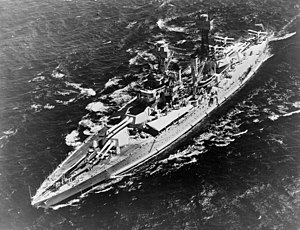
Back USS Maryland (BB-46) Afrikaans Мериленд (линеен кораб, 1920) Bulgarian USS Maryland (BB-46) Czech USS Maryland (BB-46) German USS Maryland (BB-46) Spanish یواساس مریلند (بیبی-۴۶) Persian USS Maryland (BB-46) French USS Maryland (skip út 1921) Frisian מרילנד (BB-46) HE USS Maryland (BB-46) ID
 USS Maryland (BB-46) underway in 1935
| |
| History | |
|---|---|
| Name | Maryland |
| Namesake | Maryland |
| Ordered | 5 December 1916 |
| Builder | Newport News Shipbuilding |
| Laid down | 24 April 1917 |
| Launched | 20 March 1920 |
| Commissioned | 21 July 1921 |
| Decommissioned | 3 April 1947 |
| Fate | Sold for scrap, 8 July 1959 |
| General characteristics | |
| Class and type | Colorado-class battleship |
| Displacement | 32,600 long tons (33,100 t) |
| Length | 624 ft (190 m) |
| Beam | 97 ft 6 in (29.72 m) |
| Draft | 30 ft 6 in (9.30 m) |
| Speed | 21.17 kn (39.21 km/h; 24.36 mph) |
| Complement | 1,080 officers and enlisted |
| Armament | |
| Armor |
|
| Aircraft carried | 4 × floatplanes |
| Aviation facilities | 2 × aircraft catapults |
USS Maryland (BB-46), also known as "Old Mary" or "Fighting Mary" to her crewmates, was a Colorado-class battleship. She was the third ship of the United States Navy to be named in honor of the seventh state. She was commissioned in 1921, and serving as the flagship of the fleet, cruised to Australia, New Zealand, and Brazil.
During World War II, she was on Battleship Row during the Attack on Pearl Harbor, and was lightly damaged by Japanese bombs. Returning to duty in 1942, she saw service in the Pacific War, first supporting the rest of the fleet at the Battle of Midway, and then patrolling the Fiji Islands to guard against Japanese incursion. Next, she went on the offensive, commencing shore bombardments in the Battle of Tarawa and later in the Battle of Kwajalein. During the Battle of Saipan she took torpedo damage to her bow, necessitating repairs and refits. She then participated in the Battle of Leyte Gulf where she was hit by a kamikaze. She took another kamikaze hit at the Battle of Okinawa, then completed repairs and upgrades at Bremerton, WA. She was sailing back to the Pacific Theater when word was received that the war had ended, so she turned around and returned to the Port of Long Beach, CA.
After service in Operation Magic Carpet, she was decommissioned in 1947, and sold for scrap in 1959. She received seven battle stars for World War II service.